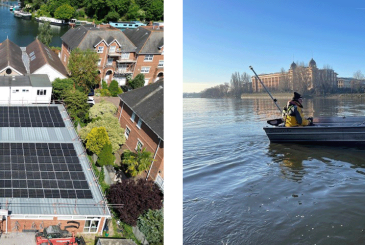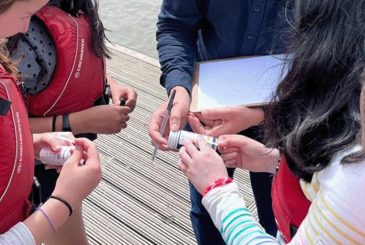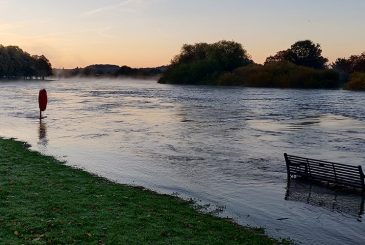For rowers who prefer not to race, what are the options for more memorable sessions and alternative events? Helena Smalman-Smith suggests how you can take recreational rowing further
If there’s one word that described living through lockdowns for those of us lucky enough not to have suffered badly from the effects of the pandemic, it was ‘DULL’. Variety, it turned out, really is the spice of life.
So now that we’re back in the usual swing of things (more or less), how do we make sure that we don’t slip into a rowing rut?
For race rowers, the target of peaking for a regatta provides an effective structure. Recreational groups, however, need to create their own ways to keep things fresh and plan special occasions that everyone will look forward to and remember later.
Read on for five fun options.

Before that, one super-simple way to ring the changes is with boat types. Quads, doubles and singles are often the staples for rec groups, and for good reasons, but there are many different types of racing boats and if you have access to them, why not consider trying something new AND build your skills? Who dares to pair? Can’t wait to eight? You (foot) steer, we cheer!
1 Challenge yourself: set a goal and record your distance
I’m happy to admit that I’m a late adopter when it comes to tech. Friends had been telling me for years that, “If it’s not on Strava, it doesn’t count” (other activity apps are also available). And I’d never got their urgent need to press ‘go’ on their smart watches or phones before pushing off the landing stage even for a pleasant evening paddle.
But when Lockdown 3 bit, in desperate search of a way to ‘share’ my lonely weekend cycles with the rowing tribe I no longer saw, I signed up for the free version myself. I was hooked!
Distance logging, using an app or spreadsheet is a great personal or group motivator and works even better if you set targets. A month’s a good time frame; pick a distance that’s challenging without being too daunting, and if it’s for the group, don’t forget that in the best tradition of SMART goal setting, it will work best if it’s ‘agreed’.
Your goal can either be just a round number or something a bit more fun like the equivalent of rowing from Land’s End to John O‘Groats, or the distance to somewhere from your club. You could even celebrate reaching it with a matching snack for your post-outing coffee that day. Rowing ‘to Paris? Pains au chocolat! Rowing ‘to’ Vienna? Sachertorte!
“Keep your group together on a picnic row by putting weaker members in larger boats”
2 Picnic or café rows
This one doesn’t need any explanation, but it won’t work for every club because it depends on the availability of a pub or picnic spot within reasonable rowing distance and, crucially, of course, somewhere you can leave your boat. This often comes down to the type of boat you’re in: skiffs, gigs and other boats without riggers can easily get into a wharf, but racing and explore-style boats will need a piece of bank that’s low enough to the water to land on (and possibly someone bringing trestles by car).
One solution to this logistical challenge is to row – often through locks – to another club.
Some years ago, when I coached on a school’s annual J14 training camp based in Henley, a regular highlight used to be taking our whole flotilla down to Marlow where we had a picnic on the landing stage. The group was kept together by putting the stronger members in singles and the weaker ones in quads.

Simon Wright, who runs the popular social rowing group at Swanage Sea Rowing Club, says: “On Friday afternoons we usually have a three-hour session rowing in the bay, which includes calling in at a beach café for a break and a chat.”
Plus, with the luxury of space along the Jurassic Coast, sometimes they simply drop anchor and have a picnic on board instead!

3 Create some boat shapes!

This one comes from Alastair Horn, who was coaching at Eton Excelsior RC back in 2018 when Prince Harry and Meghan Markle were married at nearby Windsor Castle.
“It seemed fitting for our juniors to be a part of the occasion in some way, as we’re in the royal town of Windsor,” he explains.
“My initial plan was to create the letters ‘H+M’, but then I had the idea of the heart because the kids are always making heart signs with their hands. We took out every available club single and I took the photo from the footbridge at Bray.”
As well as creativity and a convenient bridge for the photographer to stand on, the essential requirement here is for water that’s still enough so that the picture can be assembled safely, without damage to your own equipment or getting in the way of other river traffic. An early morning may be the best time.
So, what other pictures can you make with boats?
You tell us – and please do post on social media – but some ideas are ‘rowers do geometry (triangles, squares, pentagons), snowflakes, zigzags, or even your club initials.
These unusual photos could come in handy for publicity, too.
4 Go the distance!
Aside from the two established rowing marathons in England – the 49.2km Boston Marathon and the 21.5km Great Ouse Marathon – which are at the more serious end of the long-distance rowing spectrum, there are several mid-distance events which have more of a ‘festival’ atmosphere. Although these are races, in that times are taken, they also have an emphasis on fun and spectacle, and are all in places which are so interesting that it’s worth entering just to have the opportunity to row there.
“I wanted a challenge and our club is great for encouraging you to do events outside your comfort zone”
The biggest challenge for many British Rowing clubs will be finding a boat for most of these as ‘fine’ racing boats are not always suitable (or even allowed).
Here are three mid-distance events to try.
Great Tyne Row

Where? Through the centre of Newcastle
When? Cancelled for 2021, but start planning for 2022! Check here for updates.
How far? 25km with the tide (about two hours)
What boat types? Stable/Explore-style coxed boats, St Ayles skiffs, Whitby-style fours, Celtic longboats
Why? Best Dressed Crew, Best Decorated Boat and ‘Enjoying the View’ (slowest crew) awards
Hayden Hamilton from Tyne United RC took part last time the event ran in 2019.
“I wanted a challenge and our club is great for encouraging you to do events outside your comfort zone,” she explains. “There was also a fancy dress involved and I made the costumes!”
Monster the Loch

Where? Loch Ness
When? Saturday, 18 September 2021 – check here for updates.
How far? 21 miles
What boat types? Any ‘seaworthy’ boat
Why? Amazing scenery, taking on the elements, chance of seeing Nessie?
Great River Race

Where? The tidal Thames from Greenwich to Richmond
When? Saturday, 25 September 2021 – check the event’s Twitter feed here.
How far? 21.6 miles with the tide (around three hours)
What boat types? Coxed, fixed seat boats
Why? So many different sorts of boats, jostling for position, hilarious fancy dress
5 Dressage/’One Day Event’
Can rowing borrow any ideas anything from equestrianism? Stick with me here. Clearly, we both do races, but riders also compete in dressage (described as ‘dancing horses’ when it grabbed the public’s imagination at the 2012 Olympics) and sometimes combine these skills tests with various types of jumping in three-part ‘one day events’, which comprise dressage, a longer distance, timed, cross-country course over jumps, and then timed show jumping, again with penalty points for refusals or jumps knocked down.
While we’re never going to be able to get our boats to jump, here’s how you could run an informal one-day rowing event with a recreational squad which would test skills and endurance as well as raw speed. Devise a scoring system to give equal weight to each part.
Dressage
A skills test which competitors either have to memorise or are prompted by someone on the bank. It could be done in singles or crew boats (if coxed: it tests the cox’s commands and control of the boat too). The precision and accuracy of each element would be marked by judges.
Here’s an example:
- From stationary, tap down and hands away and balance boat with blades off water for five seconds.
- Tap turn anti-clockwise and then clockwise.
- Row square blades arms, then with body swing, half slide, and full slide for five strokes each.
- Single strokes/pauses at quarter slide (particularly challenging for crew boats).
- Stroke-side square blades/bow-side feathered for five strokes then change to the other way round for five strokes OR roll both handles through 360-degrees on the way forward OR square and feather twice on the way forwards.
Cross-country
A longer-distance timed piece on an ‘out and back’ course with turning time included. This tests skill and endurance as well as raw speed. Set off head-race style.
Showrowing
A very short-timed piece (e.g. 200m), again with a head-race style start. Boats start in reverse order of the standings so far, with a live leader board.
Recreational rowing resources
If you don’t have any equipment, but want to put on an event or do a challenge, then check out the Charles Stanley Boat hire offer from the recreational rowing committee.
You can find out more about recreational rowing here.
Plus, you can watch our special webinar on recreational rowing and hear from a panel of experts.
Finally, don’t forget your insurance cover!
British Rowing ROW membership will give you insurance cover for recreational rowing and local events, so it’s worth members of recreational groups joining – plus there are lots of additional membership benefits such as store discounts and being able to read articles like this on British Rowing Plus!
Photos: James Andrews, Alistair Horn, Phil Pring, Rowtours.com, Helena Smalman-Smith, Swanage Sea Rowing Club










